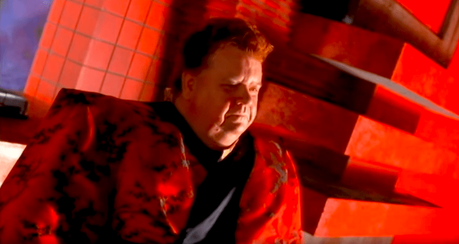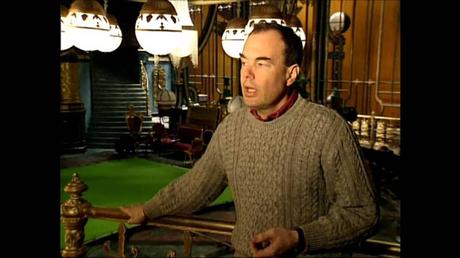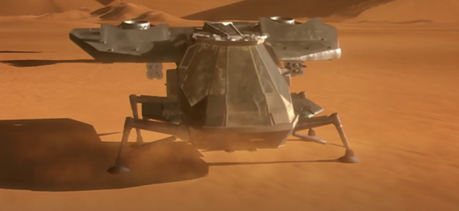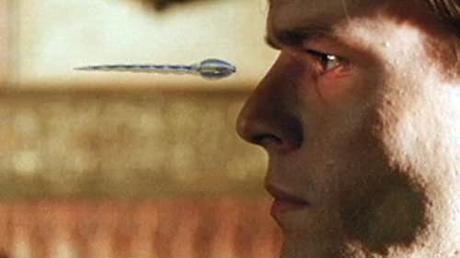 The evil Baron Harkonnen (Ian McNeice) in the Sci-Fi Channel's 'Dune' miniseries from 2000
The evil Baron Harkonnen (Ian McNeice) in the Sci-Fi Channel's 'Dune' miniseries from 2000
Writer-director John Harrison, visual effects supervisor Ernest Farino, editor Harry Miller, and production team assistants Greg Nicotero and Tim McHugh participate in the audio commentary that accompanied the Special Edition Director's Cut of Artisan's three-disc DVD edition of Dune. The following represents an annotated transcription of their thoughts, opinions and viewpoints on the subject of Frank Herbert's cinematic novelization.
Originally, the first scene of the Sci-Fi Channel's three-night Dune series took place on the Harkonnen home planet of Giedi Prime, with the bad guy, the overly rotund Baron (Ian McNeice), pontificating at length about the plot, and the subsequent relationships between the various characters. However, the consensus among these craftsmen became that audiences would rather see the "hero" (young Paul Atreides) right off the bat, the one who would emerge as the saga's chief protagonist, ergo the one to root for.
This conceit might possibly have been rethought for the upcoming Denis Villeneuve version (soon to appear in theaters and online streaming). That remains to be seen. Usually, the bad guys tend to be the most interesting characters. Whether this is true or not is a matter of opinion. Certainly the "baddies" are notoriously the best acted and/or the sexiest members of the cast - at the least, that is the perception. If this holds true, then viewers are in for an exciting ride.
As previously indicated, sound stages in Prague, Czech Republic, were set up for the Sci-Fi Channel's series and utilized in a quasi-operatic "stage style," offset with trans-lights and green screens. Too, the lighting style was most effective as background. Accents, that is foreign accents, represented a jumble of Irish brogue and American English with regional Czech and/or Eastern European influences, along with cultivated British-speak, and (believe it or not) were basically unplanned. To viewers' good fortune, this United Nations-polyglot assemblage of makeshift "ambassadors" made for enriched performances.
The essence of a scene was preserved, the rule of thumb being, "Are we telling the story efficiently and quickly?" Sets were built to scale (remarkable in widescreen mode), with sufficient scope and size to impress viewers, but not to overwhelm the actors. Wooden floors, beautifully crafted and constructed, stood out prominently, although some sequences were "adapted," as Harrison stated, with an eye toward "keeping the spirit of a scene."

For instance, the Atreides are different from the Harkonnens, in looks and bearing. Also, the soundscape was created to give the impression that the capital city of Arrakeen was alive and present (even though sequences were shot on a soundstage). That clash of accents and the lack of intelligibility hampered the production crew at the start of filming, but they quickly overcame the hurdles (think: Miloš Forman's Amadeus, also shot in Prague with a predominantly Czech crew and extras).
Hot reds, cool blues, warm browns - this color palette proved useful to the emotional content of the storytelling, as suggested earlier, plus the added advantage of elaborate costumes in support of this theme. These were employed in tandem with the exaggerated (the term "hyperbolized" was again voiced) lighting effects, which embodied the theatricality aspects the creators found to their liking. Subtle changes within scenes, temperature gradations and such, were, as noted, done in "concert with the script and the requirements, emotionally and plot-wise, of the story itself."
Problems with noise and booms on the soundtrack necessitated redubs of dialogue to stress understanding and audibility, the result of lighting designer Vittorio Storaro's use of sound boards - a clear example of the technical aspects of filmmaking clashing with the needs of the production.
FX - Special and OtherwiseOne question that continued to pop up: How did the FX crew provide the glowing blue eyes of the Fremen, and of young Paul as Maud' Dib? They determined that to paint each of the eyes digitally was not only impossible but unworkable - there were too many of them to begin with. Their solution? Contact lenses treated to reflect black light, thus making the spice's effect believable as well as practical.
Other matters, for instance time-changing aspects, geared specifically to the novel, and those infamous interior monologues - the thing that bogged down the David Lynch production - were carefully considered. Instead, a straight-ahead, basically linear narrative was utilized to preserve clarity for the viewer. Writer Harrison opted for "suggestive motives" for the characters' behavior or action. Where internalization was called for, a less subtle solution was applied.
Another FX challenge was the thopter, those insect-like flying contraptions with wings that flutter, in itself an aerodynamically implausible design and tricky to realize. As a compromise, the production crew went about modifying a delta-wing design that was split in the back to give the "sense" of flying wings without actually flapping in fact (as a real-world insect would). This solution has been worked out, more or less successfully, in the 2021 Dune feature, which reverted to Frank Herbert's original intensions for this airborne transport.

On a side note, the character of Liet Kynes, played by English actress Sharon Duncan-Brewster, the Dune planet's so-called "planetologist," has undergone a gender as well as a color change to a Black female in director Villeneuve's Dune production. In the context of this latest entry, these alterations make perfect sense: Zendaya, the young actress hired for the role Chani, is also dark-skinned. And as fans of the novel know, the warrior maiden Chani is revealed to be Kynes' daughter. So, in terms of story, this gender-substitution actually helps the plot along rather than detracts from it.
Genealogically speaking, desert dwellers do tend to be darker skinned than their lighter-skinned counterparts. This would mean that, in general, North African and Middle Eastern residents have darker skin so as to reflect the sun's rays. In a similar light, Scandinavians, then, because of their colder climate, have blondish hair and lighter skins, which tend to absorb sunlight.
Area 51, the FX specialists involved in the production, created a CGI-desert that resembled the Prague stage set in most respects. The thopter, in the initial sandworm sequence at the start, really looked like a flying insect, all of them CGI effects that, according to the techies, took "weeks and weeks" of planning and work to get right.
Oftentimes, the FX shots are blended many weeks and months after the actors themselves have been shot. Composites are needed to be made that complement what the actors were either referring to or looking at: i.e., those giant worms, in one instance. The right emotional quality must be matched and timed to perfection. Let it be known that the worm attacks, and several others later on, remain one of the most impressive in the Sci-Fi Channel's 2000 version, a real accomplishment for early television CGI work.
The Shadow of His SmileThe shadow that crosses and divides Paul's facial features as he and his father ride past a group of Fremen villagers indicates a split in Paul's nature. At first, he is simply the son of Duke Leto Atreides. Later, Paul becomes the future savior of his people, thus the lighter and darker facets of his character are brought out and stressed, done literally with lighting. Both the danger and the serene aspects that reside within the younger Atreides, and that inevitably clash within him, have yet to take place. That occurrence will shortly consume him, as his part in the nascent saga - at best, a very crucial part - emerges and develops.
Camera movement, sharp right angles for the Harkonnen, tilted, raked and distorted, along with that red and black color scheme, all factor in the visuals. There is a dark contrast between this brutish bunch and the earth-bound inhabitants of Arrakeen. This leads to Paul's on-the-spot learning about Arrakis and the Fremen's mythology. Harrison comments that several sequences in the book were combined and/or excerpted into others, principally (as stated earlier) for clarity. "The book is dense," Harrison goes on to mention, and thick with symbolism, heavy with meaning. "The spice is everywhere." And we should feel ourselves being enveloped by it.
Hunter-seekers, those tiny dart-like weapons, are everywhere. If one of them gets into your bloodstream it can disrupt the nervous system. One particular hunter-seeker meets a violent end in a water pitcher. This bold attempt to take Paul's life meets with the appropriate action: an enraged Duke Leto issues an order to find the person responsible. "I want him alive. Alive!" the Duke demands. Unfortunately, his war master Gurney Halleck (P.H. Moriarty) disposes of the traitor all-too-handily. This sets up a conflict in which the audience is led to believe that Gurney could have turned on the Duke and his clan.

At the Atreides gathering that evening, a fancy ball is in progress. According to actor William Hurt, who embodied the elder Duke, he envisioned Leto as a "doomed character. And Leto knows it." Ergo, Hurt played him that way. His focus and purpose was to prepare his son Paul to take over the reins of power and leadership. This inevitability, the fact that Paul's father is on an irreversible course, makes Duke Leto out to be a mythic character, a "hero" in the classic sense - Achilles, Siegfried, Darth Vader, et al. Leto guides his son along a predestined path, to follow in his footsteps (to coin a cliched phrase) as the next in line for dukedom.
"Trust no one," Leto admonishes. This limits Paul's chances for intimacy with, well, basically anyone. Who can he trust? Who can he confide in? if the Harkonnen can kill within the palace walls, there is no stopping them.
'To Be or Not to Be': That's a Question, Not an AnswerAt the start of the saga, there were 244 FX shots. The special effects team ended up with over 600 shots! Ecology, as the main theme, took precedence. Interior monologues were eliminated, as previously asserted. Harrison continued to stress that he had to seek ways to externalize those monologues through action and dialogue. "Nothing slows a movie down like listening to a character's thoughts," he mused. For example: "Is there a traitor among our own?" This can be both an external idea and an internal one. Which way is better? There is no "right" answer. But one thing is certain: repetition breeds contempt for the process.
Gurney Halleck, the Duke and Paul's protector, manages to convince young Atreides of his sincere love for his father. "Whiny, bratty and petulant" Paul, as enacted by Alec Newman, learns to become a man. The commentary here indicates that Harrison was criticized for treating the character as a spoiled child at the start. Later, of course, Paul becomes a godlike messiah. Similarly, Luke Skywalker also began as an impetuous, adventure-seeking adolescent until, through circumstances out of his control, he acquired self-knowledge and realized his potential as a future Jedi master.
The hero's journey, as Joseph Campbell phrased it, has come full circle.
Later that night, Paul has a vision of his father's death. And Paul breaks down, weeping bitterly. At this juncture, Duncan Idaho (James Watson) now introduces Duke Leto to a potential ally: the distrusting, steely-eyed Stilgar. Paul's transformation - his spiritual journey, as it were - is played out over three parts, or "acts." And "Graeme Revell's music carries the spirit of the story. It becomes a story element in itself" (as previously discussed in Part Four: https://josmarlopes.wordpress.com/2021/06/20/i-will-face-my-fear-the-mind-killing-little-deaths-of-dune-part-four/).
The shot of the empty chair, an effective use of the lighting board (with lights going out on the chair itself) symbolizes the coming demise of Leto's power and influence. Yet, the Duke continues to make sporadic appearances throughout the series, sometimes in Paul's dreams, at other times in surreptitious circumstances.
He's like the Ghost of Hamlet's deceased father, murdered by his uncle, the current occupant of the throne and an adulterer to boot. In this context, Paul is Prince Hamlet, youthful, immature, unsure of what to do, unable to act. "To be or not to be?" To act or not to act? What to do? How to do it? Indecisions, indecisions!
This all changes with his coming of age, as we shall see.
"The saga of Dune is far from over...."
(To be continued...)
Copyright © 2021 by Josmar F. Lopes
